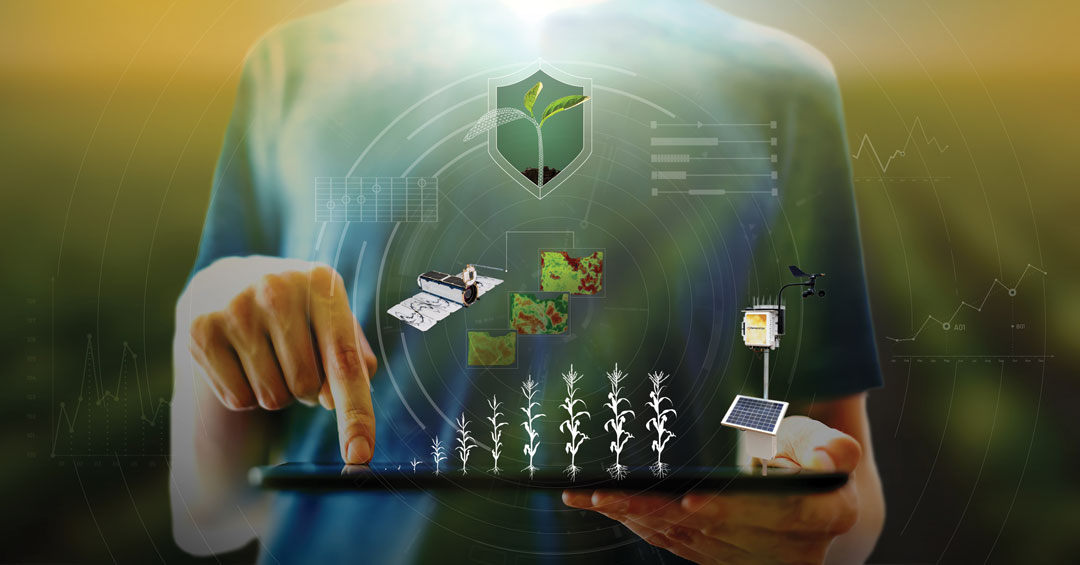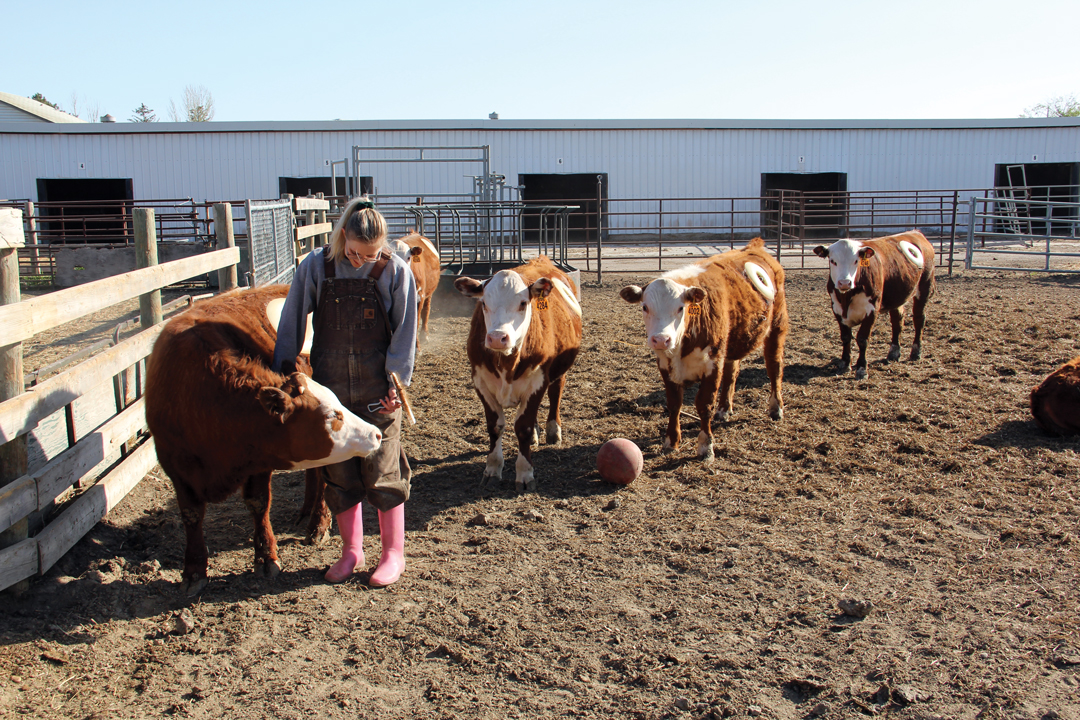THE PLUGGED-IN FARMER
BY JACK GATES • IMAGES COURTESY OF FARMERS EDGE
Until recently, the concept of a digitally connected farm seemed far off. In fact, it is the emerging reality for modern farming. From sensors that offer constant soil analysis, to software programs that provide real-time crop data for tractor cabs, the technology is at a farmers doorstep, bringing with it a host of opportunities and challenges.
DIGITAL OPPORTUNITIES
“The connected farm is about using time, equipment and resources more efficiently,” said Shane Thomas, global digital ag lead for Farmers Edge in Calgary. The company develops data-driven technologies to enhance farm efficiency. In this brave new world, Thomas foresees the interconnection of all farm elements such as bins, shops, trucks, equipment, moisture probes and weather stations.
“Whether it’s real-time remote monitoring of bins, autonomous fleet management or virtual interaction among farm partners such as agronomists and bankers, the changes will be profound,” said Thomas. “This will bring the ability to manage the farm more like a manufacturing plant because of an acute awareness of what’s happening in every area of the operation and the power to control or automate those areas in
the future.”
When it comes to making best use of the new technology, every farm is different, so costs and labour requirements will vary. Thomas believes the bottom line is those who put an appropriate amount of effort and expense into the process will get the most out of it.
“Maximizing your return from this technology is like a fitness program,” said Thomas. “If you simply put in 30 minutes a day, three days a week at a medium intensity with no trainer, no diet plan and no progression in the routine, your results will be minimal. If you hire a trainer, get a diet plan, go five days a week and research supplements, the results can be massive. The same is true for a connected farm and digital tools. It comes down to identifying your goals and priorities and committing the time to get there.”
Perhaps most importantly, connectivity requires a change in mindset from product to system.
“We are hard-wired in agriculture to think about inputs on the farm in a linear fashion, where you buy product X, apply it and get a result that is either positive or negative,” said Thomas. In contrast, digitally connected systems will require farmers and other ag professionals to stretch their mindset to embrace a variety of disciplines and longer time horizons, he said. For example, data collected by a piece of farm machinery that is digitally connected to a telematics device may not have direct use in year one. In year two, however, this data may enable the farmer to participate in a sustainability or carbon credit program.
Another farmer may look back at collected data to discover a pesticide product was mis-applied. Such data may shed light on why there is carryover of a specific herbicide or identify their most fuel-efficient tractor as they begin equipment upgrades.
OBSTACLES AWAIT
In spite of its potential benefits, connectivity can involve a steep learning curve that may be intimidating to the uninitiated. Offering constructive feedback, institutions are responding to the need for knowledge on many fronts.
“We are already seeing this response with a lot of educational institutes integrating new connectivity into farm management programs like the one at Olds College,” said Brianna Gratton who works as a smart ag techgronomist at the college. A working farm operation, its Smart Farm incorporates cutting-edge technology to give students connected, hands-on learning.
“Our program is training the next generation to be ready when connectivity is fully up and running,” said Gratton. “We also encourage farmers to do their research around this technology. Things can look flashy when they first come on the market, but farmers should investigate how these improvements can enhance their bottom line.”
For some in rural areas, another challenge is having the proper connection to make best use of the emerging technology. Corporations such as Telus and John Deere will eventually have farm specific, private connection options, but there is no firm timeline for implementation. 5G connectivity is another possibility to aid farmers, as it allows mobile and stationary devices to transmit data in the absence of a plug-in. Again, the timing is uncertain for when 5G could come to rural Alberta.
“The greatest need for farms right now is connectivity across the entire operation,” said Gratton. “A lot of farmers have coverage gaps in their home or tractor, so a service provider could set themselves apart by enabling users to stream all data into one place and make real-time decisions based on that data.” Farmers need reliable service, good range, reasonable costs and ease of use, she added. They want something that will work when they need it to work and not cost more than the benefits they derive from it.
On its Smart Farm, Olds College is testing LoRaWAN, a point-to-multipoint networking protocol that could offer solutions for farmers lacking strong connections. While it is a costly investment, Gratton said it’s not the only game in town. Sensor and equipment manufacturers such as Saskatoon’s North Star Systems are bringing additional farm connectivity products to market. “It goes back to providing uniform telemetry across the farm, and it will be up to farmers to see what works for them and how they can tie it all together,” said Gratton.

OPPORTUNITY SEIZED
Given the advantages of connectivity can only be realized when the technology is accessed, there is a push to expand rural access on a national scale. “I am pleased with what I see out of the American and Canadian governments these days,” said Mark Young, chief technology officer and head of product for Climate FieldView. The company helps farmers maximize data inputs to boost their bottom line.
“There is strong recognition in both [Canada and the U.S.] of the need for rural broadband and cellular connectivity on the farm, and not just for harvesting crops but for running a family operation,” said Young.
Whether it’s allowing young people to access the internet and correspond with friends, tapping into health-care resources online or managing a bank account and paying bills, the need for connectivity is great.
“The good news is that many states and provinces have very good coverage right now, but the downside is the void that still exists in a number of areas,” said Young. “I am a huge proponent of full coverage and spend a lot of time talking to legislators in Washington, D.C., and Ottawa.”
Last year, Young’s efforts produced a $200 million grant from the United States Department of Agriculture, followed by a $1 billion grant six months ago, to expand rural broadband south of the border. He is confident that a similar commitment can be secured one day in Canada and stressed the need to speak with one voice in conveying the importance of connectivity for all concerned.
“Harnessing the power of connectivity is more crucial today than ever before,” said Young. “Farming costs have become prohibitive and margins are tight, so farmers need to be able to take advantage of those things that are under their control. They can’t influence the weather or global grain markets, but they can decide how they use data to make better decisions in real time that will lower costs, decrease risk and increase profits.”







Comments